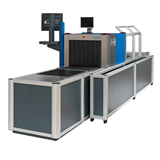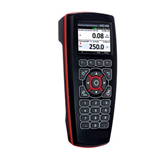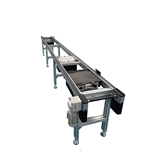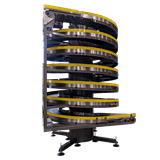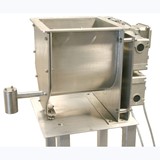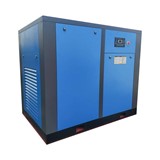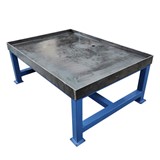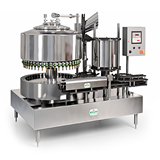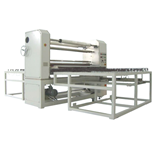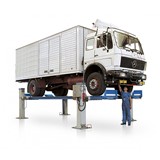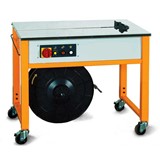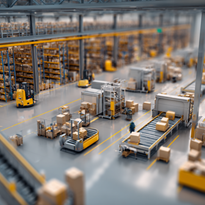In today's rapidly evolving business landscape, optimizing operational efficiency and streamlining processes are key factors for success. One crucial aspect of achieving these goals is selecting the right conveyor system for your business. A well-designed conveyor system can significantly enhance productivity, reduce labor costs, and improve overall workflow. With numerous options available in the market, choosing the perfect conveyor can be a daunting task. However, fear not, as we are here to guide you through the process of selecting the ideal conveyor system that aligns with your business needs and objectives.
Understanding Your Business Requirements
Before delving into the world of conveyor systems, it is vital to assess your specific business requirements. Take a holistic view of your operations, considering factors such as the nature of your products, production volume, space availability, and the flow of materials within your facility. Understanding these elements will help you identify the key features and capabilities you need in a conveyor system.
Types of Conveyor Systems and Their Uses
Conveyor systems come in various types, each designed to cater to specific applications. Let's explore the most common types of conveyor systems and their uses in different industries:
1. Belt Conveyors
Belt conveyors are widely used in industries that involve the transportation of bulk materials or products on a continuous basis. They consist of a continuous loop of material, typically made of rubber, that rotates around two or more pulleys. Belt conveyors are versatile and can handle a wide range of products, from lightweight to heavy and irregularly shaped items. They are commonly used in industries such as mining, agriculture, manufacturing, and logistics.
2. Roller Conveyors
Roller conveyors use a series of rollers to transport goods. They provide a cost-effective solution for moving products smoothly and efficiently. Roller conveyors are ideal for handling packages, cartons, and pallets. They can be gravity-powered or motorized, depending on the application. Roller conveyors are commonly used in industries such as warehouses, distribution centers, and e-commerce fulfillment centers.
3. Chain Conveyors
Chain conveyors are designed for heavy-duty applications and are capable of handling bulky and heavy items with ease. They utilize chains to move materials along the conveyor path. Chain conveyors are commonly used in industries such as automotive, manufacturing, and warehousing, where robust and reliable transportation is required. They are particularly useful in applications that involve high-temperature or abrasive materials.
4. Screw Conveyors
Screw conveyors are ideal for moving materials that have a semi-fluid or sticky consistency. They consist of a rotating helical screw blade within a tube, which propels materials forward. Screw conveyors are commonly employed in industries such as food processing, wastewater treatment, and agriculture. They are versatile and can handle a wide range of materials, including powders, granules, and sludge.
5. Modular Conveyor
Modular conveyor belts are composed of individual plastic modules that interlock to form a continuous belt. These modules typically have a standardized size and shape, allowing for easy replacement and customization. The belts are constructed with high-quality materials such as polypropylene or polyethylene, ensuring durability, strength, and resistance to wear and tear. Some modular belts feature open areas or perforations to facilitate drainage or airflow, making them suitable for specific applications.
Factors to Consider When Buying a Conveyor System
When it comes to optimizing your business operations, selecting the right conveyor system is a critical decision. A well-designed conveyor system can improve productivity, enhance efficiency, and streamline your workflow. With a plethora of options available in the market, it's essential to consider several factors to ensure you choose the ideal conveyor system for your business needs. In this comprehensive buying guide, we will explore the key factors you should consider when purchasing a conveyor system.
1. Application Requirements
The first step in selecting a conveyor system is understanding your specific application requirements. Consider the type of products you handle, their size, weight, and shape. Determine the speed and throughput required for your operations. Evaluate whether you need accumulation capabilities or if your products require special handling. By identifying your application requirements, you can narrow down the options and choose a conveyor system that best suits your needs.
2. Conveyor Type
There are various types of conveyor systems available, each designed for specific applications. Some common types include:
- Belt Conveyors: Ideal for transporting bulk materials or products continuously, belt conveyors are versatile and can handle a wide range of items. They are widely used in industries such as mining, manufacturing, and logistics.
- Roller Conveyors: These conveyors utilize rollers to move goods smoothly along the conveyor path. They are suitable for handling packages, cartons, and pallets and are commonly used in warehouses and distribution centers.
- Chain Conveyors: Designed for heavy-duty applications, chain conveyors are capable of transporting bulky and heavy items. They are commonly used in automotive and manufacturing industries.
- Screw Conveyors: These conveyors use a rotating helical screw blade to move materials with a semi-fluid or sticky consistency. They are commonly employed in industries such as food processing and wastewater treatment.
- Modular Conveyor: Ideal for a wide range of applications in the automotive and manufacturing industries. They are used for the transportation of automotive components, parts, and assemblies throughout the production process.
Consider the specific features and advantages of each conveyor type and choose the one that aligns with your application requirements.
3. Conveyor Length and Configuration
Assess the available space in your facility to determine the appropriate conveyor length and configuration. Consider the layout of your production area and the flow of materials. Evaluate whether you need straight conveyors, curved conveyors, or a combination of both. Additionally, consider factors such as inclines, declines, and any obstacles or obstructions that may affect the conveyor's path. By optimizing the length and configuration of the conveyor system, you can maximize efficiency and minimize space constraints.
4. Speed and Capacity
Evaluate the speed and capacity requirements of your operations. Determine the desired conveyor speed based on your production needs and product handling capabilities. Consider factors such as loading and unloading times, cycle times, and any specific requirements for maintaining product integrity. Additionally, assess the conveyor's capacity to handle the anticipated volume of materials or products. Ensure that the selected conveyor system can accommodate your production goals without compromising efficiency or product quality.
5. Conveyor Safety and Maintenance
Safety is paramount in any industrial setting. When choosing a conveyor system, consider the safety features incorporated into the design. Look for features such as emergency stop buttons, safety guarding, and sensors to prevent collisions or accidents. Additionally, consider the ease of maintenance and accessibility for cleaning, repairs, and routine maintenance tasks. A well-maintained conveyor system ensures optimal performance and reduces the risk of downtime.
6. Integration with Existing Equipment
If you have existing equipment or machinery in your facility, ensure compatibility and integration with the chosen conveyor system. Consider the interfaces required for seamless integration, such as electrical connections, pneumatic connections, and control systems. Evaluate whether the conveyor system can easily connect to your existing infrastructure without the need for significant modifications or additional equipment. Smooth integration reduces downtime and allows for a more efficient workflow.
7. Durability and Reliability
Investing in a durable and reliable conveyor system is crucial for long-term success. Consider the quality of materials used in the construction of the conveyor system, such as the frame, belts, chains, and rollers. Look for reputable manufacturers known for producing reliable and durable equipment. Additionally, consider factors such as the system's load-bearing capacity, resistance to wear and tear, and the availability of spare parts. A reliable conveyor system minimizes maintenance requirements, reduces the risk of breakdowns, and ensures uninterrupted operations.
8. Energy Efficiency
In today's environmentally conscious world, energy efficiency is an important consideration. Look for conveyor systems that are designed to minimize energy consumption. Consider features such as variable speed drives, which allow you to adjust the conveyor speed to match the production requirements. Additionally, look for systems that incorporate energy-efficient motors and controls. Choosing an energy-efficient conveyor system not only reduces your environmental footprint but also lowers your energy costs over time.
9. Cost Analysis
While it's important to consider the upfront cost of the conveyor system, it's equally crucial to conduct a comprehensive cost analysis. Evaluate the long-term costs associated with the system, including maintenance, repairs, and energy consumption. Consider the return on investment (ROI) and the potential cost savings the system can provide in terms of increased productivity, labor reduction, and improved operational efficiency. A thorough cost analysis ensures that you make an informed decision based on both immediate and long-term financial considerations.
Conveyor System Budgeting: How Much Should You Spend?
Investing in a conveyor system for your manufacturing or distribution facility is a significant decision that requires careful budgeting. While it's important to choose a conveyor system that meets your operational needs and provides long-term value, it's equally crucial to determine how much you should allocate for this investment. In this article, we will discuss factors to consider when budgeting for a conveyor system and help you determine an appropriate spending range.
1. Assess Your Needs and Requirements
Before setting a budget for a conveyor system, it's essential to assess your facility's specific needs and requirements. Consider factors such as the type and volume of products you handle, the layout of your facility, production goals, and any unique challenges or constraints you may have. Understanding your needs will help you determine the level of automation, conveyor type, capacity, and features required, which in turn affects the overall cost.
2. Determine the Scope of the Project
The scope of your conveyor system project will play a significant role in determining the budget. Consider the scale of the installation, including the number of conveyor lines, the length and complexity of the system, and any additional equipment or accessories needed. A larger or more complex project will generally require a higher budget to account for the increased materials, labor, and engineering involved.
3. Research and Compare Costs
Conduct thorough research to gain insights into the current market prices for conveyor systems. Reach out to multiple suppliers and manufacturers to obtain quotes and compare costs. Keep in mind that prices can vary based on factors such as conveyor type, system configuration, material quality, and additional features or customization. By comparing costs from different suppliers, you can identify a price range that aligns with your budget.
4. Consider Total Cost of Ownership
When budgeting for a conveyor system, it's crucial to consider the total cost of ownership (TCO) rather than solely focusing on the upfront cost. TCO includes not only the initial purchase price but also ongoing expenses such as maintenance, repairs, spare parts, energy consumption, and labor. A conveyor system with a slightly higher upfront cost but lower maintenance and energy costs may provide better long-term value. Evaluate the TCO of different options to make an informed decision.
5. Plan for Installation and Integration
Don't overlook the costs associated with the installation and integration of the conveyor system. Factor in expenses such as engineering services, equipment installation, electrical work, and any necessary modifications to your facility. Additionally, consider the time required for installation and how it may impact your operations. It's advisable to work closely with the conveyor system supplier or a professional integrator to develop a detailed installation plan and budget accordingly.
10 Tips for Buying Used Conveyor Systems
When it comes to acquiring a conveyor system for your business, buying used equipment can be a cost-effective option. However, it's crucial to approach the process with caution and thorough consideration. Used conveyor systems can offer significant savings, but it's important to ensure that you're making a wise investment. In this article, we will provide you with valuable tips for buying used conveyor systems to help you make an informed decision.
1. Evaluate Your Needs
Before diving into the used conveyor market, it's essential to evaluate your specific needs. Determine the type of products you'll be handling, the required speed and capacity, and any special features or configurations you may require. By having a clear understanding of your needs, you can narrow down your search and focus on finding used conveyor systems that are suitable for your operations.
2. Research Reputable Sellers
When buying used equipment, it's crucial to source from reputable sellers. Research and identify sellers or dealers known for their expertise in the conveyor industry and their commitment to quality. Look for companies that have a good reputation, positive customer reviews, and a track record of providing reliable used equipment. Buying from trusted sellers increases the likelihood of acquiring a well-maintained conveyor system.
3. Inspect the Equipment
Before making any purchase, thoroughly inspect the used conveyor system. Ideally, visit the seller's facility to see the equipment firsthand. Check for signs of wear and tear, damage, or any mechanical issues. Pay close attention to critical components such as belts, motors, rollers, and controls. If you're unable to inspect the equipment in person, request detailed photographs and videos to assess its condition. It's essential to ensure that the used conveyor system is in good working order and meets your quality standards.
4. Inquire About Maintenance History
Request information about the maintenance history of the used conveyor system. Ask the seller for records of regular maintenance, repairs, and any upgrades or modifications that have been made. A well-maintained conveyor system is more likely to offer reliable performance and longevity. Understanding the maintenance history gives you insight into how the equipment has been cared for and can help you assess its overall condition and potential lifespan.
5. Consider Customization and Compatibility
Evaluate whether the used conveyor system can be customized or modified to meet your specific requirements. Determine if it can be integrated with your existing equipment or if any adaptations will be necessary. Consider factors such as conveyor length, configuration, speed adjustments, and control compatibility. While used equipment may not offer the same level of flexibility as new systems, it's essential to ensure that it can be adapted to fit your operational needs.
6. Request a Test Run
Whenever possible, request a test run of the used conveyor system. Seeing the equipment in action allows you to assess its functionality, noise levels, smoothness of operation, and any potential issues. A test run provides firsthand experience and helps you make a more informed decision about the equipment's suitability for your operations. If a test run is not feasible, ask the seller if they can provide video footage of the equipment in operation.
7. Understand Return Policies and Warranty Options
Before finalizing the purchase, clarify the seller's return policies and warranty options for the used conveyor system. Although used equipment generally carries a lower warranty period than new equipment, it's still important to understand the level of support provided by the seller. Discuss any concerns or questions you may have regarding returns, repairs, or warranty coverage to ensure that you are comfortable with the terms and conditions of the purchase.
8. Consider Installation and Support
When buying a used conveyor system, consider the installation process and ongoing support. Determine if the seller provides installation services or if you'll need to arrange for installation yourself. If you're responsible for installation, ensure that you have the necessary resources, expertise, and equipment to properly install and integrate the used conveyor system into your facility. Additionally, inquire about the availability of technical support from the seller in case you encounter any issues or require assistance during the installation or setup process.
9. Calculate Total Cost of Ownership
While the initial purchase price of a used conveyor system may be lower, it's crucial to calculate the total cost of ownership (TCO) to make an informed decision. Consider factors such as maintenance and repair costs, potential downtime, energy consumption, and the expected lifespan of the equipment. Although used equipment may have a shorter remaining lifespan compared to new systems, a well-maintained and properly functioning used conveyor system can still offer significant cost savings over its remaining service life.
10. Seek Recommendations and Expert Advice
Don't hesitate to seek recommendations and expert advice when buying a used conveyor system. Consult with professionals in the industry or reach out to colleagues who have experience in purchasing used equipment. They can provide valuable insights, share their experiences, and offer guidance on what to look for and what to avoid. Their expertise can help you navigate the used equipment market with confidence.
In conclusion, choosing the right conveyor system for your business requires careful consideration of various factors. By assessing your needs, understanding the types of conveyor systems available, considering safety and maintenance requirements, evaluating integration and compatibility, and conducting a cost analysis, you can make an informed decision. Additionally, when buying used conveyor systems, it is important to evaluate your specific needs, research reputable sellers, thoroughly inspect the equipment, inquire about maintenance history, consider customization and compatibility, request a test run if possible, understand return policies and warranty options, consider installation and ongoing support, calculate the total cost of ownership, and seek recommendations and expert advice. By following these tips, you can select a conveyor system that optimizes efficiency, productivity, and overall success for your manufacturing or distribution facility.




-160x160-state_article-rel-cat.png)
-160x160-state_article-rel-cat.png)
